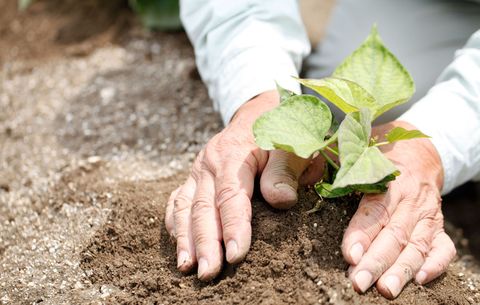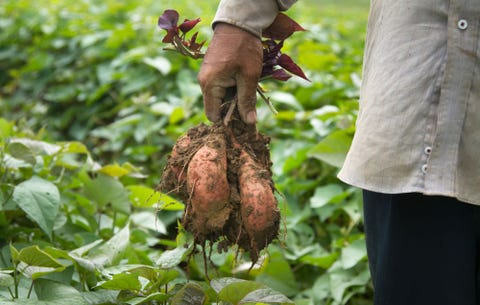These tubers can flourish in even the poorest conditions with just a little bit of TLC.

In the garden, on a trellis, or in a container, sweet potatoes are a beautiful plant. The delicious tubers in the fall just come as an added bonus to the lovely foliage and flowers.
Sweet potatoes grow well in a sunny vegetable garden, but you can also grow them in other parts of your home landscape.
Try them as a temporary groundcover or a trailing houseplant. In a patio planter, a sweet potato vine will form a beautiful foliage plant that you can harvest roots from in the fall.
Try them as a temporary groundcover or a trailing houseplant. In a patio planter, a sweet potato vine will form a beautiful foliage plant that you can harvest roots from in the fall.
This warm-weather crop grows worldwide, from tropical regions to temperate climates. The flesh is classified as either moist or dry. Moist, deep orange types (sometimes called yams) are more popular with home gardeners, especially the varieties Centennial and Georgia Jet.
Sweet potatoes are also remarkably nutritious and versatile; each fleshy root is rich in vitamins A and C, along with many important minerals. Use them raw, boiled, or baked, in soups, casseroles, [desserts], breads, or stir-fries — and don’t forget to try some homemade sweet potato fries!
Planting

Sweet potatoes will grow in poor soil, but deformed roots may develop in heavy clay or long and stringy in sandy dirt. To create the perfect environment, create long, wide, 10-inch-high ridges spaced 3½ feet apart. (A 10-foot row will produce 8 to 10 pounds of potatoes.)
Work in plenty of compost, avoiding nitrogen-rich fertilizers that produce lush vines and stunted tubes. In the North, cover the raised rows with black plastic to keep the soil warm and promote strong growth.
Advertisement - Continue Reading Below
It’s best to plant root sprouts, called slips, available from nurseries and mail-order suppliers. (Store-bought sweet potatoes are often waxed to prevent sprouting). Save a few roots from your crop for planting next year.
About six weeks before it’s time to plant sweet potatoes outdoors in your area, place the roots in a box of moist sand, sawdust, or chopped leaves in a warm spot (75 to 80 degrees). Shoots will sprout, and when they reach 6 to 9 inches long, cut them off the root. Remove and dispose of the bottom inch from each slip, as that portion sometimes harbors disease organisms.
Sweet potatoes mature in 90 to 170 days and they’re extremely frost sensitive. Plant in full sun three to four weeks after the last frost when the soil has warmed. Make holes 6 inches deep and 12 inches apart. Bury slips up to the top leaves, press the soil down gently but firmly, and water well.
Growing

If you’re not using black plastic, mulch the vines two weeks after planting to smother weeds, conserve moisture, and keep the soil loose for root development. Occasionally lift longer vines to keep them from rooting at the joints, or they will put their energy into forming many undersized tubers at each rooted area rather than ripening the main crop at the base of the plant. Otherwise, handle plants as little as possible to prevent wounds that vulnerable disease spores.
If the weather is dry, provide 1 inch of water a week until two weeks before harvesting, then let the soil dry out a bit. Don’t overwater, or the plants — which can withstand dry spells better than rainy ones — may rot.
Protecting Against Pests

Sweet potato weevils — ¼-inch-long insects with dark blue heads and wings and red-orange bodies — puncture stems and tubers to lay their eggs. Developing larvae tunnel and feed on the fleshy roots, while adults generally attack vines and leaves. They also spread foot rot, which creates enlarging brown to black areas on stems near the soil and at stem ends.
Since weevils multiply quickly and prove hard to eliminate, use certified disease-resistant slips and practice four-year crop rotation. Destroy infected plants and their roots, or place in sealed containers and dispose of them with household trash.
Fungal diseases include black rot, which results in circular, dark depressions on tubers. Discard infected potatoes, and cure the undamaged roots from the same crop carefully. Don’t confuse this disease with less-serious scurf, which creates small, round, dark spots on tuber surfaces but doesn’t affect eating quality.
Stem rot, or wilt, is a fungus that enters plants injured by insects, careless cultivation, or wind. Even if this disease doesn’t kill the plants, the harvest will be poor. Minimize the chances of disease by planting only healthy slips; avoid black and stem rot by planting resistant cultivars. Reduce the incidence of dry rot, which mummifies stored potatoes, by keeping the fleshy roots at 55 to 60 degrees.
Harvesting

You can harvest as soon as leaves start to yellow, but the longer a crop is left in the ground, the higher the yield and vitamin content. Once frost blackens the vines, however, tubers can quickly rot.
Use a spading fork to dig tubers on a sunny day when the soil is dry. Remember that tubers can grow a foot or more from the plant, and that any nicks on their tender skins will encourage spoilage.
Dry tubers in the sun for several hours, then move them to a well-ventilated spot and keep at 85 to 90 degrees for 10 to 15 days. After they are cured, store at around 55 degrees, with a humidity of 75 to 80%. Properly cured and stored sweet potatoes will keep for several months.
Source: goodhousekeeping


No comments:
Post a Comment